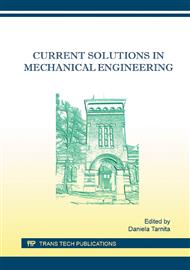[1]
R. Xiao-ping and C. Zi-xing, Using the ackerman principle for kinematic modeling of wheeled mobile robots, School of Information Science & Engineering, Central South University, Changsha, (2009).
Google Scholar
[2]
M. Bak, N. K. Poulsen, and O. Ravn, Path following mobile robot in the presence of velocity constraints, Informatics and Mathematical Modelling, Technical University of Denmark, DTU, (2001).
DOI: 10.23919/ecc.2001.7076071
Google Scholar
[3]
M. D. Berkemeier, Optimal, stable switching between arcs during low-speed ackerman path tracking, in American Control Conference (ACC), p.1362–1367, (2013).
DOI: 10.1109/acc.2013.6580026
Google Scholar
[4]
L. I. G. Calandín, Modelado cinemático y control de robots móviles con ruedas, Ph.D. dissertation, Universidad Politécnica de Valencia, (2010).
DOI: 10.4995/thesis/10251/1840
Google Scholar
[5]
N. Chakraborty and A. Ghosal, Kinematics of wheeled mobile robots on uneven terrain, Mechanism and Machine Theory, vol. 39, no. 12, p.1273 – 1287, 2004, 11th National Conference on Machines and Mechanisms (2003).
DOI: 10.1016/j.mechmachtheory.2004.05.016
Google Scholar
[6]
J. J. Craig, Adaptative control of mechanical manipulators. AddisonWsley, (1988).
Google Scholar
[7]
Davidson and V. Bahl, The scalar econtroller: a spatial path tracking approach for odv, ackerman, and differentially-steered autonomous wheeled mobile robots, in Robotics and Automation, ICRA. IEEE International Conference, vol. 1, p.175–180, (2001).
DOI: 10.1109/robot.2001.932549
Google Scholar
[8]
Economou, P. C. K. Luk, A. Tsourdos and B. A. White, Hybrid modelling of an all-electric front-wheel ackerman steered vehicle, in Vehicular Technology Conference. VTC. IEEE 58th, vol. 5, p.3294–3298. (2003).
DOI: 10.1109/vetecf.2003.1286276
Google Scholar
[9]
J. Economou and R. Colyer, Fuzzy hybrid modelling of an ackerman steered electric vehicle, International Journal of Approximate Reasoning, vol. 41, no. 3, p.343 – 368, (2006).
DOI: 10.1016/j.ijar.2005.08.002
Google Scholar
[10]
Li and M. Trentini, Tracking control of autonomous vehicles with slippage, in Autonomous and Intelligent Systems (AIS), , p.1–6. (2010).
DOI: 10.1109/ais.2010.5547029
Google Scholar
[11]
C. Li Xiaohui, S. Zhenping, C. Qingyang, and W. Jian, A novel path tracking controller for ackerman steering vehicles, in Control Conference (CCC), 32nd Chinese, p.4177–4182. (2013).
Google Scholar
[12]
M. Minami, T. Ikeda, and M. Takeuchi, Dynamic model of mobile robot including slipping of car- rying objects, International Journal of Innovative Computing, Information and Control, vol. 3, no. 2, p.353–369, (2007).
Google Scholar
[13]
M. Molina, L. S, and E. Rodriguez, Pathfollowing with diferential mobile robot, USB- Med, vol. 5, no. 1, (2014).
Google Scholar
[14]
Nourani-Vatani, J. Roberts, and M. V. Srinivasan, Practical visual odometry for car-like vehicles, in Robotics and Automation. ICRA'09. IEEE International Conference , p.3551–3557, (2009).
DOI: 10.1109/robot.2009.5152403
Google Scholar
[15]
Y. Raeisi, K. Shojaei, and A. Chatraei, Output feedback trajectory tracking control of a car-like drive wheeled mobile robot using RBF neural network, in Power Electronics, Drives Systems & Technologies Conference (PEDSTC), 6th, 2015, p.363–368, (2015).
DOI: 10.1109/pedstc.2015.7093302
Google Scholar
[16]
A. G. Roy, P. Rakshit, A. Konar, S. Bhattacharya, E. Kim, and A. K. Nagar, Adaptive firefly algorithm for nonholonomic motion planning of car-like system, in Evolutionary Computation (CEC), p.2162–2169. (2013).
DOI: 10.1109/cec.2013.6557825
Google Scholar
[17]
Y. N. S. Hoshino, H. Seki and J. Ota, Faulttolerant multi-robot operational strategy for ma terial transport systems considering maintenance activity, Journal of Robotics and Mechatronics, vol. 22, no. 4, p.485–495, (2010).
Google Scholar
[18]
K. SEO and J. S. LEE, Kinematic pathfollowing control of a mobile robot under bounded angular velocity error, Advanced Robotics, vol. 20, no. 1, p.1–23, (2006).
DOI: 10.1163/156855306775275512
Google Scholar
[19]
Smid, K. C. Cheok, R. E. Karlson, and G. Hudas, Unified intelligent motion planning for omni-directional vehicles, in Intelligent Vehicles Symposium, p.419–424, (2004).
DOI: 10.1109/ivs.2004.1336420
Google Scholar
[20]
M. A. Sotelo, Lateral control strategy for autonomous steering of ackerman-like vehicles, Robotics and Autonomous Systems, vol. 45, no. 3–4, p.223 – 233, (2003).
DOI: 10.1016/j.robot.2003.09.002
Google Scholar
[21]
Y. Wang, S. Wang, R. Tan, and Y. Jiang, Motion control of a wheeled mobile robot using digital acceleration control method, International Journal of Innovative Computing, Information and Control, vol. 9, no. 1, (2013).
Google Scholar
[22]
A. J. Weinstein and K. L. Moore, Pose estimation of ackerman steering vehicles for outdoors autonomous navigation, in Industrial Technology (ICIT), p.579–584, (2010).
DOI: 10.1109/icit.2010.5472738
Google Scholar
[23]
R. Siegwart, I. Nourbakhsh, Introduction to Autonomous Mobile Robots, Massachusetts Institute of Technology, (2004).
Google Scholar


